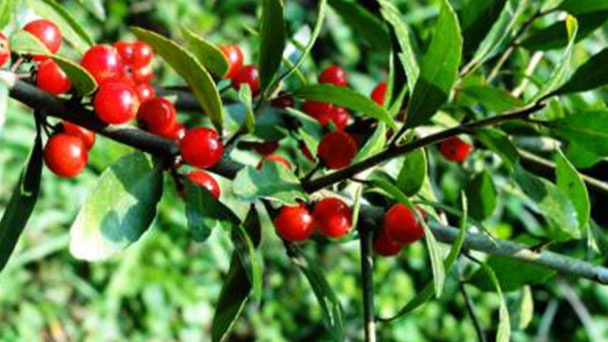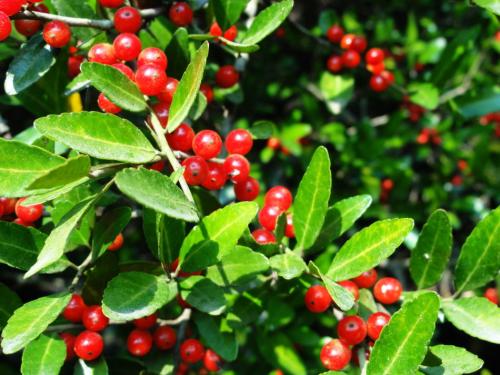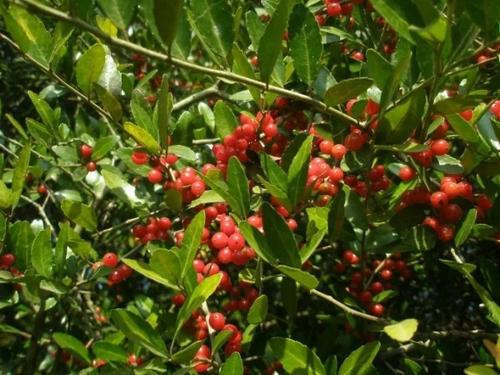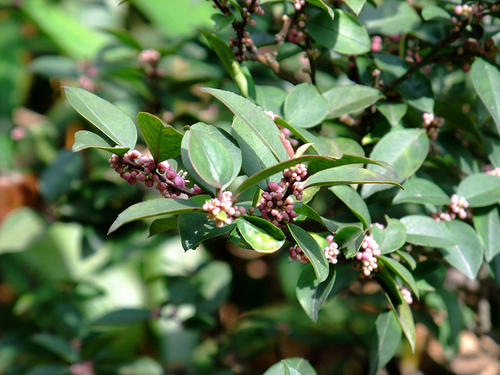Yaupon Holly (Ilex Vomitoria) Profile: Care & Growing Facts
Written by Maggie
Nov 13 2021

Yaupon Holly (scientific name: Ilex Vomitoria) is a Holly native to southeastern North America, including Maryland to Florida in the south and Oklahoma in the west, Texas and Chiapas in Mexico.
Yaupon Holly Picture

Yaupon Holly Info
| Botanical Name | lex vomitoria |
| Common Names | Yaupon holly, youpon holly, cassina |
| Plant Type | Broadleaf evergreen shrub or small tree |
| Mature Size | 10 to 30 feet tall; 8- to 12-foot spread (shorter dwarf varieties are also available) |
| Sun | Full sun to part shade |
| Flower Color | Greenish-white, followed by red berries |
| Hardiness Zones | 7 to 9 (USDA) |
| Native Area | Southeastern U.S., Mexico |
Yaupon Holly Characteristics
Yaupon Holly is an evergreen plant, 10-20 inches tall, with a smooth, grayish trunk and slender, hairy branches. Leaves alternate, ovate to elliptic, rounded at the tip, obtuse or coarsely serrate at the margin, 1 -- 4.5 cm long and 1 -- 2 cm wide, glossy dark green at the top and pale at the bottom. Flowers 5 -- 5.5 mm in diameter, with a four-petaled corolla of white.The fruit is small, 4-6 mm in diameter, red (and sometimes yellow), with four seeds, and is spread by birds eating the fruit. What distinguishes them from Holly carrii is their smaller leaves, and the shape of the leaves' tips. Yaupon Holly has a rounded tip, while Holly carrii has a sharp tip.
Read More:
12 Wonderful Evergreen Shrubs for Your Garden
Yaupon Holly Growing Conditions
Yaupon Holly generally grows in sandy soil with good dewatering near the shore, and can also be found in salt marshes, dunes, non-coastal wetlands, forests and pine and dwarf forests. Yaupon Holly's fruit is an important food for many birds, such as the red-billed duck, the green-billed black duck, the mourning pigeon, the ruffed grouse, the American masked pheasant, the wild Turkey, the flushing bird, the sucker woodpecker, the cedar bird, the eastern bluebird, the American thrushbird, the North American catbird, the northern mockingbird and the white-throated finch.Mammals that eat Yaupon Holly fruit include nine-band armadillos, American black bears, grey foxes, raccoons and weasels. The white-tailed deer will also eat its leaves and branches.
How to Care for Yaupon Holly
Yaupon Holly Light Requirements
Yaupon holly grows nicely in a full-sun to part-shade location. It flourishes pleasant with masses of sunlight.
Yaupon Holly Soil Care
This shrub prefers sandy soil, however does pretty properly in different soil textures, as well. It has a correct tolerance for salty soils, making it a precise preference for planting close to the ocean.
Yaupon Holly Watering
Water the root ball two or three instances a week for the first 12 months after planting, then weekly thereafter. Well mounted plant life can tolerate some drought.
Yaupon Holly Temperature & Humidity
A native to the southeastern U.S., yaupon holly prefers the prerequisites frequent in that region—warm, quite humid weather. It may additionally fighting to continue to exist winters in the northern cease of its hardiness range.
Yaupon Holly Fertilizer
Feed lightly as soon as a 12 months in the spring, and keep away from high-nitrogen fertilizers.
Yaupon Holly Pruning
This shrub is frequently left greater or much less unattended to structure casual screens, however it can additionally be gently pruned at ordinary intervals to hold it formed as a hedge.
If growing it as a small tree, preserve decrease facet branches pruned away.
Diseased or broken branches need to be reduce away when they are spotted.
Badly overgrown shrubs can be rejuvenated by means of slicing away up to one-third of the branches. Cut selected stems down the base of the plant.
When shaping as a hedge, reduce the ends of branches lower back to 1/4 inch above a node going through the path you desire the department to grow.
Cut away suckers from the base of the plant as they appear, until your purpose is to motivate the shrub to develop into a thicket.

How to Propagate Yaupon Holly
Yaupon holly is satisfactory propagated from small, semi-hardwood cuttings taken in fall.
Select small branches and sever the slicing simply under a set of leaves. Remove the decrease leaves, then coat the reduce give up with rooting hormone. Place the slicing in a combination of perlite and coarse sand, and preserve the reducing moist and heat till roots develop.
After eight to 10 weeks, you can transplant the slicing into a massive pot crammed with a loam/sand mix. Some growers permit the plant to proceed developing in the pot for a full 12 months earlier than transplanting it into a everlasting panorama location.
Varieties of Yaupon Holly
The native species is relatively too fast-growing for panorama use, so most of the types planted are slower-growing cultivars, including:
'Folsom Weeping': a weeping cultivar that grows 15 to 20 ft excessive with a unfold of 10 to 15 feet
'Nana'/ 'Compacta': a dwarf girl clone, typically closing under three toes in height
'Pride of Houston': every other upward-growing lady clone that grows 15 to 20 toes in peak with a 10- to 15-foot spread
'Schilling's Dwarf'/ 'Stokes Dwarf': a dwarf male clone with round addiction developing four to 6 toes broad and tall
'Will Flemming': a male clone offering a columnar increase habit, developing 12 to 15 ft excessive with a unfold of two to three feet
Toxicity of Yaupon Holly
Like all hollies, the berries of yaupon holly include ilicin, a mildly toxic substance that is regarded unsafe to young people and animals if eaten in massive quantities. Symptoms are listed as "nausea, vomiting, diarrhea, and stupor due to despair of the central anxious system." The berries are disagreeable to the taste, however, so they are hardly ever eaten in enough portions to be harmful; no fatalities are reported. But you ought to take care when the use of holly branches as indoor vacation decorations, as the berries might also fall off and be bump off by way of pets or children.
Yaupon Holly Uses
Native Americans used the leaves and trunk of Yaupon Holly to make a tea that was used for ritual cleansing by men. The ceremony included vomiting, which Europeans mistakenly blamed on Yaupon Holly.The main ingredient is caffeine, and vomiting can be caused by studying or drinking large amounts of Yaupon Holly.

Latest Updated
- Benefits of Bugleweed - 7 Science-backed Health Benefits
- Bugleweed Dangers & Side Effects - Is It Poisonous?
- How to Plant Evergreen Trees - What You Should Know
- When to Plant Evergreens - Grow Guide for Evergreen Trees
- 12 Wonderful Evergreen Shrubs for Your Garden
- 12 Popular Evergreen Plants with Pictures for Beginners
- When And How To Prune A Lilac Bush Like a Pro
- How to Grow & Care for Lilac Vine (Hardenbergia Violacea)
- Japanese Lilac Tree (Syringa Reticulata) Care & Propagation Guide
- Shumard Oak Pros and Cons - What to Know
Popular Articles
- Winter maintenance of Antirrhinum Majus
- How to Grow Terminalia Mantaly Tree
- How to Grow and Care for Crossostephium Chinense
- How to grow Antirrhinum Majus in spring
- Peristeria Elata (Dove Orchid) Profile: Info & Care Guide
- Underwatered Snake Plant (Sansevieria Trifasciata) - Signs And How To Fix
- How to Care for Brazilian Jasmine Plant (Mandevilla Sanderi)
- How to Grow & Care for Graptopetalum Purple Delight in Summer
- Rosa Chinensis (China Rose): Plant Growing & Care Tips
- How to Care for Baby Sun Rose (Aptenia Cordifolia)